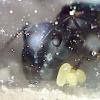Has anyone tried this? If you were to include a few (~5) workers with a founding queen in a test tube, would they assist her with tidying up the nest and caring for the brood? Or do founding queens expect to be alone?
- Formiculture.com
- Forums
- Gallery
- Members
- Member Map
- Chat



















